
Backgammon is a two-player board game played with counters and dice on tables boards. It is the most widespread Western member of the large family of tables games, whose ancestors date back at least 1600 years. The earliest record of backgammon itself dates to 17th-century England, being descended from the 16th-century game of Irish.
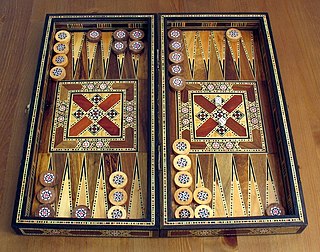
Tables games are a class of board game that includes backgammon and which are played on a tables board, typically with two rows of 12 vertical markings called points. Players roll dice to determine the movement of pieces. Tables games are among the oldest known board games, and many different varieties are played throughout the world. They are called 'tables' games because the boards consist of four quadrants or 'tables'. The vast majority are race games, the tables board representing a linear race track with start and finish points, the aim being to be first to the finish line, but the characteristic features that distinguish tables games from other race games are that they are two-player games using a large number of pieces, usually fifteen per player.
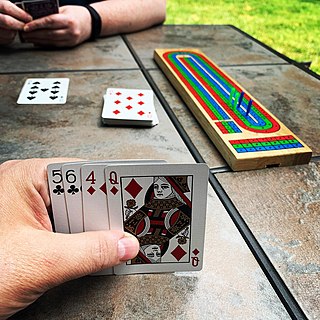
Cribbage, or crib, is a card game, traditionally for two players, that involves playing and grouping cards in combinations which gain points. It can be adapted for three or four players.

Nard is an historical Persian tables game for two players that is sometimes considered ancestral to backgammon. It is still played today, albeit in a different form. As in other tables games, the playing pieces are moved around a board according to rolls of dice. It uses a standard tables board, but has a different opening layout and rules of play from that of backgammon.

Post and Pair or Post and Pare is a gambling card game that was popular in England in the 16th and 17th centuries — another name of the game was Pink. It is based on the same three-card combinations, namely prial, found in related games of this family.

Gul bara is a tables game, an ancient genre of board games that includes Backgammon, Trictrac and Nard. It is also called Rosespring Backgammon or Crazy Narde. The aim of the game is to move all of one's men around the board and bear them off. The first player who bears off all his or her men wins. The game is popular in Bulgaria, Azerbaijan, Greece, Turkey and North Macedonia.

Tavli, sometimes called Greek backgammon in English, is the most popular way of playing tables games in Greece and Cyprus and is their national board game. Tavli is a compendium game for two players which comprises three different variants played in succession: Portes, Plakoto and Fevga. These are played in a cycle until one player reaches the target score - usually five or seven points.
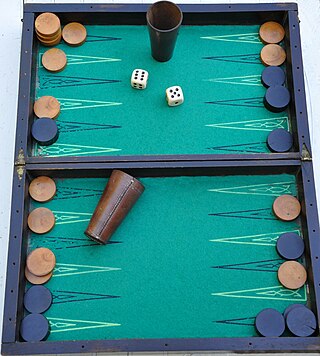
Jacquet is a tables game played on a backgammon-like board and which was once very popular in France and several other parts of Europe. It probably emerged around 1800, but is attested by 1827. In the 20th century it replaced the classic French backgammon equivalent — the game of Trictrac — until Jacquet itself was superseded by Anglo-American games in the 1960s.
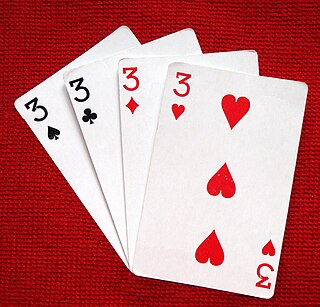
Put, occasionally Putt, is an English tavern game first recorded in the 16th century and later castigated by 17th century moralists as one of ill repute. It belongs to a very ancient family of trick-taking card games and bears close similarities a group known as Truc, Trut,Truque, also Tru, and the South American game Truco. Its more elaborate cousin is the Catelan and Spanish game of Truc, which is still much played in many parts of Southern France and Spain.
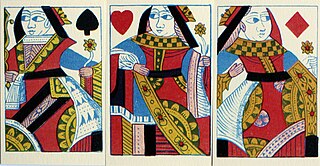
Gleek is an English card game for three people. It is played with a 44-card pack and was popular from the 16th century through the 18th century.

Trictrac is a French board game of skill and chance for two players that is played with dice on a game board similar, but not identical, to that of backgammon. It was "the classic tables game" of France in the way that backgammon is in the English-speaking world.

Tourne case or tourne-case is an historical French tables game in the same family as Backgammon. Lalanne recommends it as a children's game.

Laquet is an historical Castilian tables game that was described as a new game in the 13th century. It may be the ancestor of Jacquet. Unlike Backgammon and most other tables games, it has an asymmetrical starting position; only three of the four quadrants are used and the pieces may not be 'hit'.

The following is a glossary of terms used in tables games, essentially games played on a Backgammon-type board. Terms in this glossary should not be game-specific, but applicable to a range of tables games.
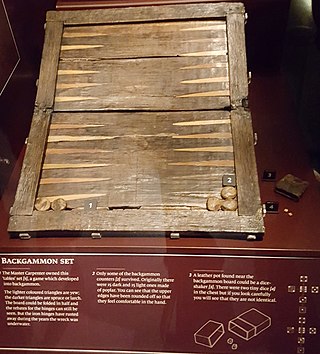
Irish or the Irish Game was an Anglo-Scottish tables game for two players that was popular from the 16th to the mid-18th centuries before being superseded by its derivative, the "faster paced" backgammon. In its day, Irish was "esteemed among the best games at Tables." Its name notwithstanding, Irish was one of the most international forms of tables games, the equivalent of French toutes tables, Italian tavole reale and Spanish todas tablas, the latter name first being used in the 1283 El Libro de los Juegos, a translation of Arabic manuscripts by the Toledo School of Translators.

Ludus Anglicorum, also called the English Game, is an historical English tables game for two players using a board similar to that used today for Backgammon and other games. It is a "strategic game for serious game-players" and was well known in the Middle Ages. At one time it was considered the most popular tables game in England.

Doublets or queen's game is an historical English tables game for two people which was popular in the 17th and 18th centuries. Although played on a board similar to that now used for backgammon, it is a simple game of hazard bearing little resemblance to backgammon. Very similar games were played in mainland Europe, the earliest recorded dating to the 14th century.
Verquere is an historical tables game. It was played by two players on a tables board of the same type as used in backgammon, but the direction and rules of play were quite different from that game.
Tawula is an historical tables game once popular in Asia Minor and Egypt. It is sometimes called Turkish backgammon in English, however this is misleading as there are fundamental differences; for example, both players move in the same direction in tawula, whereas in Backgammon they move in opposing directions.

Fevga is a popular Greek tables game for two players. It is usually played as one of three different games in succession – the others being Portes and Plakoto – in social gatherings or coffee shops. When played in this way, it is known as Tavli. Very similar games, with slight variations, are Turkish Moultezim, Russian Narde and Egyptian and Lebanese Tawla 31 or Maghribiyyah.

















